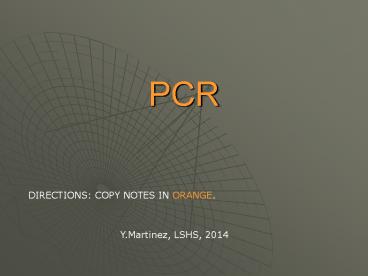PCR - PowerPoint PPT Presentation
1 / 15
Title:
PCR
Description:
Title: DNA Amplification by PCR (Polymerase Chain Reaction) Author: OT Last modified by: JohnL.Nguyen Created Date: 7/12/2006 2:54:40 AM Document presentation format – PowerPoint PPT presentation
Number of Views:133
Avg rating:3.0/5.0
Title: PCR
1
PCR
DIRECTIONS COPY NOTES IN ORANGE.
Y.Martinez, LSHS, 2014
2
What is DNA profiling?
- DNA profiling is the use of molecular genetic
methods to determine the exact genotype of a DNA
sample in a way that can basically distinguish
one human being from another. - The unique genotype of each sample is called a
DNA profile.
3
How do crime scene investigators create a DNA
profile?
- 1. Evidence is collected at the crime scene
Blood
Tissue Semen
Urine
Hair Teeth Saliva
Bone
4
- 2. DNA is extracted from sources at the crime
scene and from victim and suspects
5
- 3. DNA samples are processed
Sample Obtained from Crime Scene or Paternity
Investigation
Biology
DNA Extraction
Technology
Separation and Detection of PCR Products (STR
Alleles)
Genetics
Comparison of Sample Genotype to Other Sample
Results
6
Humans are 99.9 so
- 4. Crime Scene Investigators search in areas of
the genome that are unique from individual to
individual and are anonymous (control no known
trait or function) - The areas examined are Short Tandem Repeats or
STRs
STR region
7
To determine the genotype (DNA profile) Crime
Scene Investigators make billions of copies of
the target sequence using PCR.
Target DNA
PCR
8
Whats the point of PCR?
- PCR, or the polymerase chain reaction, makes
copies of a specific piece of DNA - PCR allows you to look at one specific piece of
DNA by making copies of only that piece of DNA - PCR is like looking for a needle in a haystack,
and then making a haystack out of the needle
9
Exons and Introns
When DNA is made, exons and introns are
made. Exons are parts of DNA our body uses for
everything! Introns are non-coding regions of
DNA or Junk DNA
10
PCR
11
- Suspects are included in an investigation if
their DNA profile matches with genotypes found at
the crime scene. - Suspects can be excluded if their DNA profile
does not match genotypes found at the crime
scene. - DNA profiling is never used alone it is used in
combination with other evidence.
12
What happens during PCR?
13
The process occurs in a machine called a
Thermalcycler. The Thermalcycler will go through
a series of heating and cooling to activate
enzymes and denature DNA. In about 3 hours, over
1 BILLION of copies of the desired gene is
replicated.
The PCR ReactionHow does it work?
14
PCR
15
(No Transcript)































